
1
lesson Medical students Medical Biology
nd
2
The flow of genetic information
It is a remarkable fact that an organism’s characteristics are encoded by a four-
letter alphabet, defining a language of three-letter words. The letters of this alphabet
are the nitrogenous bases adenine (A), guanine (G), cytosine (C), and thymine (T). So
how do these bases enable cells to function? The expression of genetic information is
achieved ultimately via proteins, particularly the enzymes that catalyse the reactions
of metabolism. Proteins are condensation heteropolymers synthesized from amino
acids, of which 20 are used in natural proteins. Given that a protein may consist of
several hundred amino acid residues.
The flow of genetic information is unidirectional, from DNA to protein, with
messenger RNA (mRNA) as an intermediate. The copying of DNA-encoded genetic
information into RNA is known as transcription (TC), with the further conversion
into protein being termed translation (TL). This concept of information flow is
known as the Central Dogma of molecular biology and is an underlying theme in all
studies of gene expression.
Transcription and translation
These two processes are the critical steps involved in producing functional
proteins in the cell. Transcription involves synthesis of RNA from the DNA template
provided by the non-coding strand of the transcriptional unit in question. The enzyme
responsible is RNA polymerase. In prokaryotes there is a single RNA polymerase
enzyme, but in eukaryotes there are three types of RNA polymerase (I, II, and III).
These synthesize ribosomal, messenger, and transfer RNAs, respectively. When the
RNA molecule is released, it may be immediately available for translation (as in
prokaryotes) or it may be processed and exported to the cytoplasm (as in eukaryotes)
before translation occurs. Translation requires an mRNA molecule, a supply of
charged tRNAs (tRNA molecules with their associated amino acid residues), and
ribosomes (composed of rRNA and ribosomal proteins). The ribosomes are the sites
where protein synthesis occurs; in prokaryotes, ribosomes are composed of three
rRNAs and some 52 different ribosomal proteins. The ribosome is a complex
structure that essentially acts as hold the mRNA in place so that the codons may be
matched up with the appropriate anticodon on the tRNA, thus ensuring that the
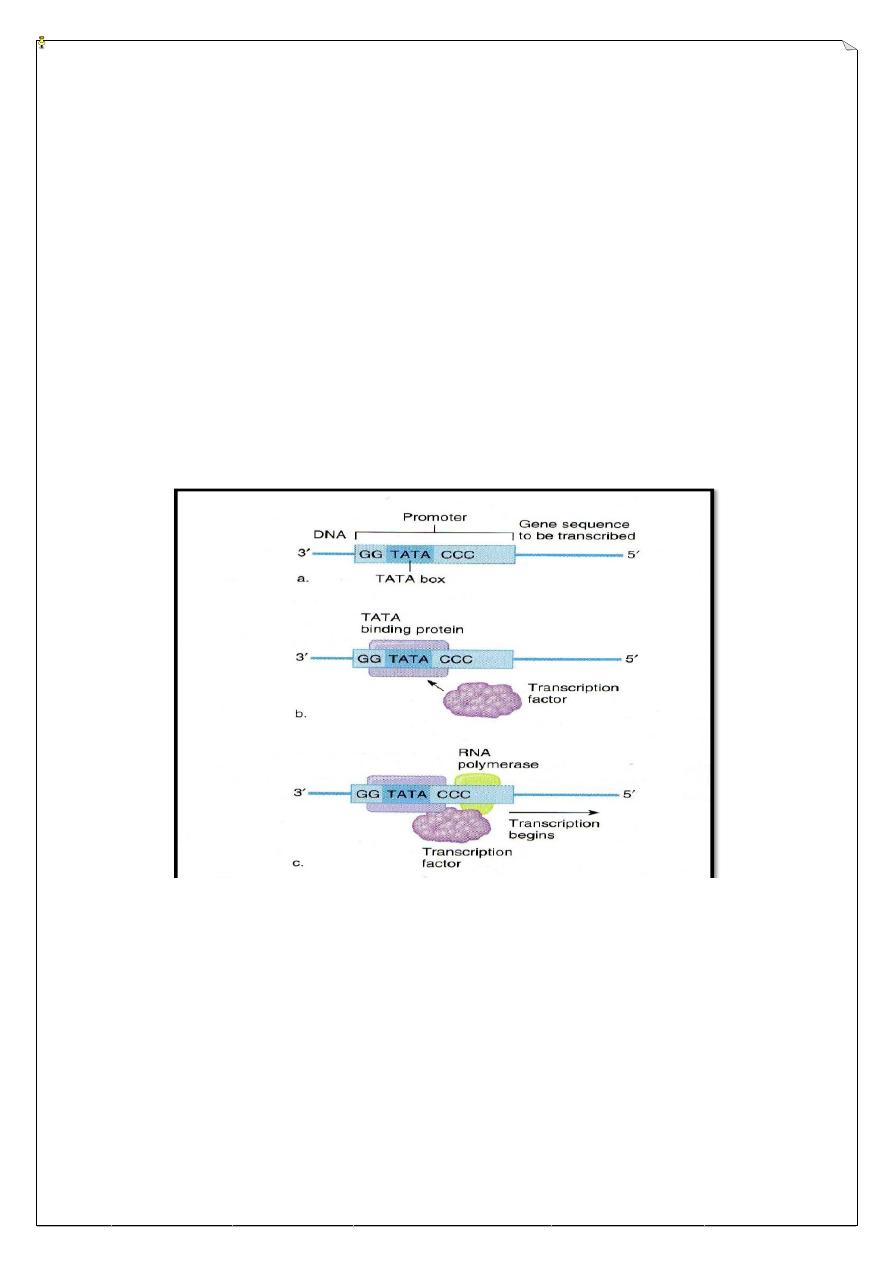
2
correct amino acid is inserted into the growing polypeptide chain.The mRNA
molecule is translated in a 5'→3' direction.
Transcription (RNA synthesis):
Transfer of genetic information from DNA by the synthesis of a complementary RNA
molecule under the direction of RNA polymerase.
Transcription occurs in three stages:
1- Initiation:
Transcription begins when transcription factors help RNA polymerase bind to the
promoter (which is a special sequence that signals the start of the gene).
Transcription factor regulate which genes are transcriped in a particular cell type.
Figure: Setting the stage for transcription to begin: a- Proteins that initiate recognize
specific sequences in the promoter region of a gene. b-A binding protein recognizes
the TATA region and binds to the DNA. This allows other transcription factors to
bind. c- The bound transcription factors form a pocket that allows RNA-polymerase
to bind and begin making RNA.
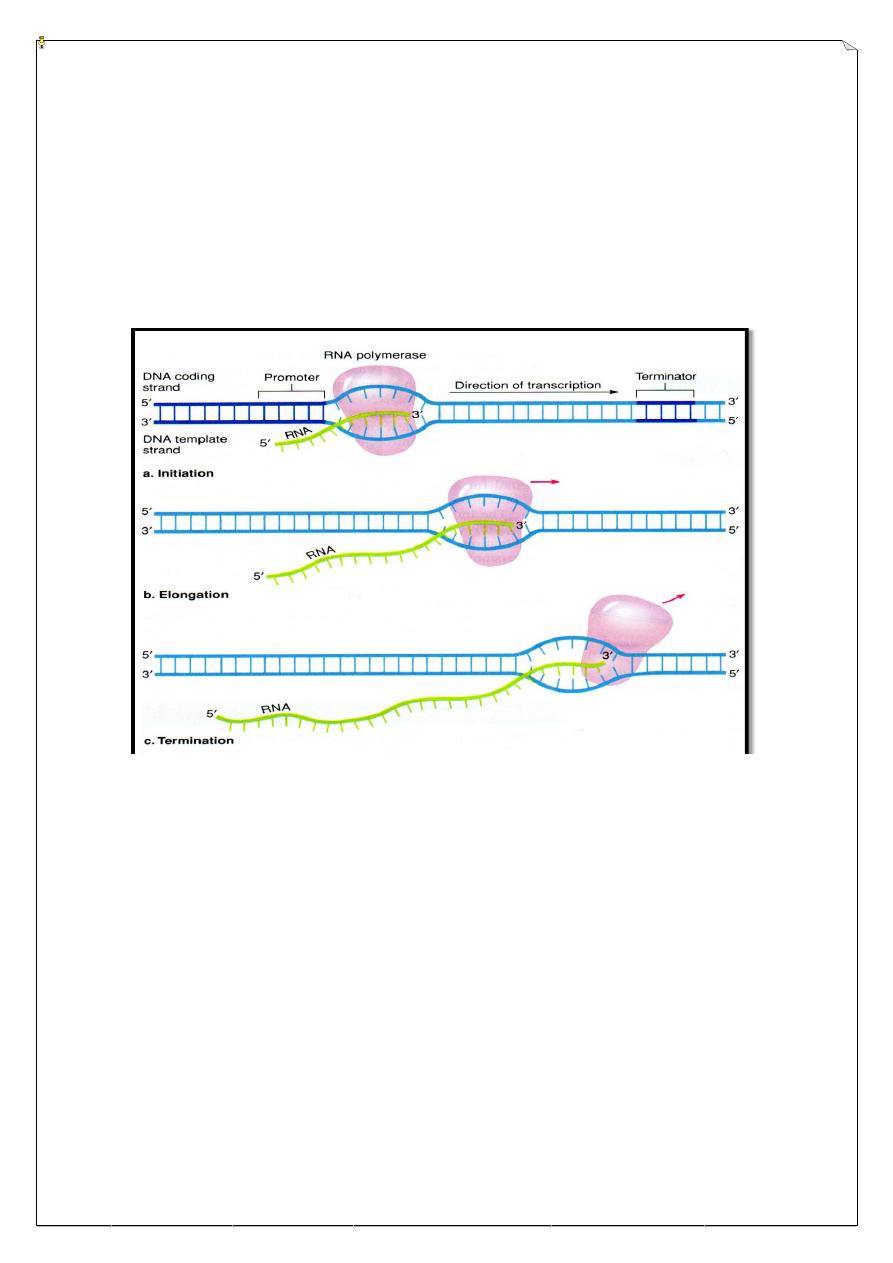
3
2- Elongation :
RNA polymerase unwind the DNA double helix locally, RNA polymerase then adds
RNA nucleotides to a growing chain, in a sequence complementary to the DNA
template strand . RNA is transcribed from the template strand of DNA.
The other DNA strand is called the coding strand.
3- Termination:
A termination sequence in the gene signals the end of transcription.
Figure: Transcription: Initiation is the control point that determines which genes are
transcribed. RNA nucleotides are added during elongation. A termination sequence in
the gene signals the end transcription.
)(لالطالع
mRNA Processing in Eukaryotes
In the nucleus, a gene composed of Exons (coding sequences) and Introns
(noncoding sequences). Both of these are transcriped to pre- mRNA or primary
transcripts (primary mRNA). Pre mRNA undergoes 3 major modifications prior to
their transport to the cytoplasm for translation:
1) 7-Methyl guanosine caps are added to the 5' ends of the primary transcripts.
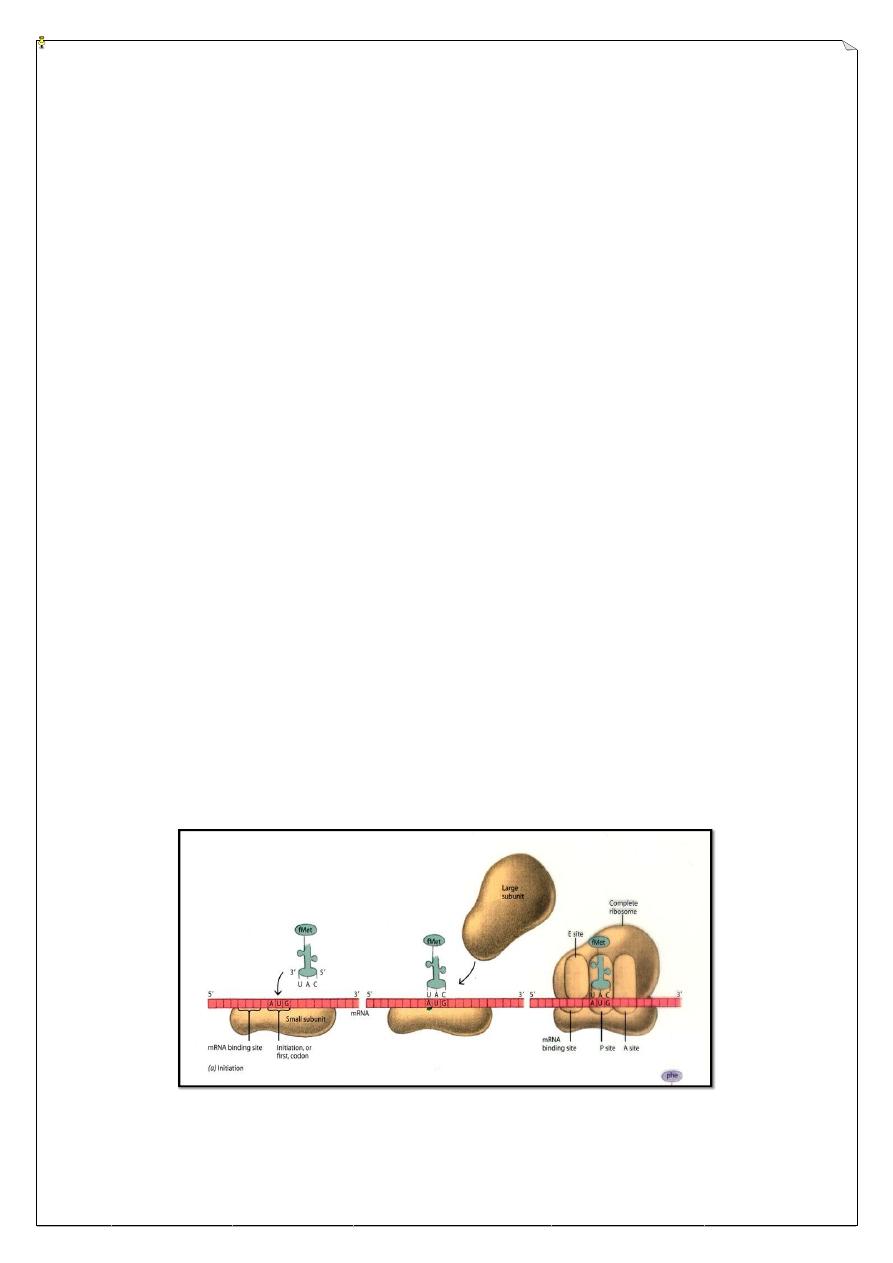
4
2) Poly (A) tails (a series of adenine molecules) are added to the 3 ends of the
transcripts. It is important for RNA stability and translation of polypeptide.
3) Processing involves spliceosomes consist of snRNAs and protein subunits in the
nucleus to remove the intron and splice together the exon into mRNA. Mature
mRNA transmits to the cytoplasm where it directs protein synthesis. Transcription
and RNA processing occur in the nucleus while translation occurs in the cytoplasm
(in Eukaryote).
Translation (Protein Synthesis)
The Process which the genetic information (which is stored in the sequence of
nucleotides in an mRNA molecule ) is translated , according to the specification of the
genetic code into the sequence of amino acids in the polypeptide gene product. A
ribosome has two subunits (each composed of rRNA and various proteins) small
subunit and large subunit. Eukaryotic ribosome (80 S) has small subunit (40 S) and
large subunit (60 S).
Protein synthesis consists of 3 phases:
1- Initiation Phase:
A small ribosomal subunit binds to mRNA: an initiator tRNA with the
anticodon UAC pairs with the start codon AUG.
The large ribosomal subunit completes the ribosome; initiator tRNA carry
methionine occupies the P-site. The A-site is ready for the second tRNA
The small and large subunit together form two tRNA binding sites P (Peptidyl)
site and A (Aminoacyl ) site .
)(لالطالع
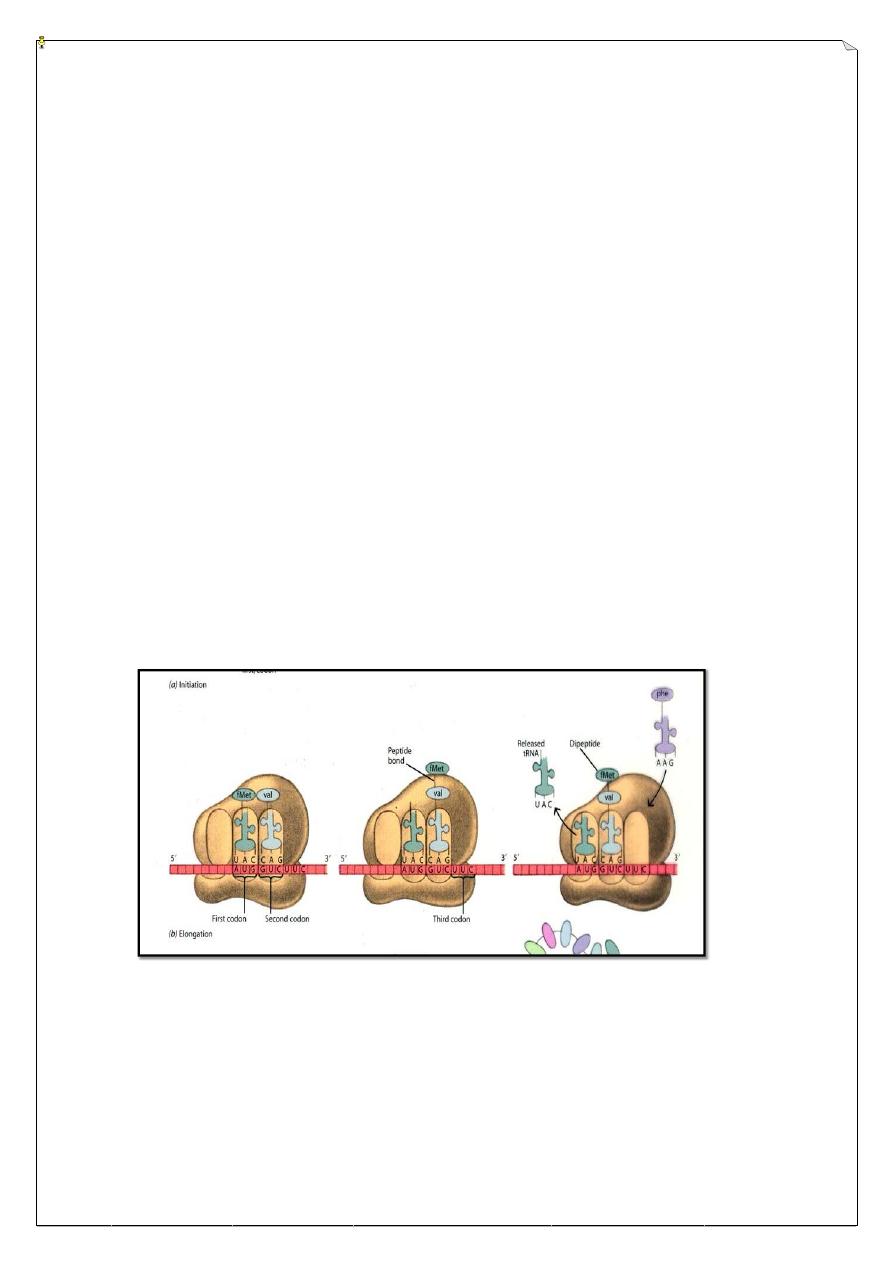
5
2- Elongation Phase: Elongation consists of 3 steps:
with an anticodon complementary to the second
harged tRNA
c
A second
st
1
codon on mRNA binds to A-site.
of the large ribosomal
(part
transferase
Peptidyl
formation:
Peptide bond
-
nd
2
subunit) can catalyze formation of peptide bond between the amino acids
carried by the two tRNAs . This bond forming reaction connects the methionine at the
P-site to the amino acid carried by the tRNA at the A-site. It also disconnects
methionine from the initiation tRNA as a result the tRNA at the A-site now carries
two amino acids.
anslocation:
Tr
-
rd
3
Three concerted movements occur, collectively called translocation.
1- Uncharged -tRNA leaves the P-site.
2- The dipeptide-tRNA in the A-site moves to the P-site.
3- The ribosome moves a long the mRNA by three nucleotides (codon) to place the
next codon in the A-site.
The empty A-site now receives another tRNA whose identity is determined by the
next codon in the mRNA and the (peptide bond formation and translocation) occurs
once again.
)(لالطالع
3- Termination Phase:
Termination of protein synthesis occurs when one of 3 stop codons (UAG,
UAA, and UGA) appears in A-site of the ribosome. A protein called release factor
recognizes stop codons and hydrolysis the bond between the last tRNA at the P-site
and the polypeptide releasing them. The ribosomal subunits dissociate.
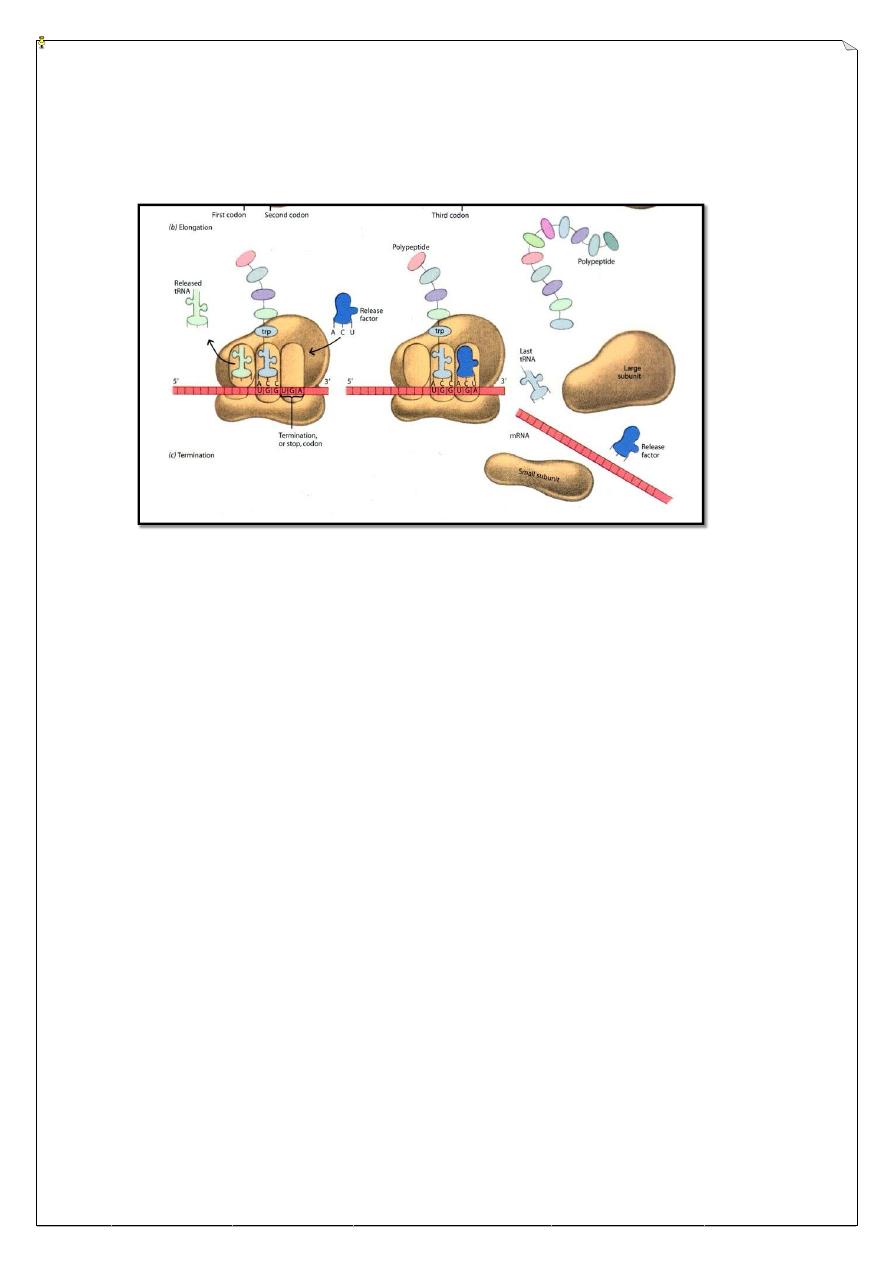
6
The resultant polypeptide chain may be enzyme, hormone, antibody, or
structural proteins.
)(لالطالع
Features of the genetic code:
1- Genetic code is Triplet: AAA code for lysine.
2- Unambiguous: each Triplet codon has only one meaning.
3- The genetic code has started and stop signals. There is one start signals (AUG).
and there is 3 stop signals ( UAA , UAG , UGA ) .
4- Universal: the code is the same and stable in all living organisms.
5- The genetic code is non-overlapping and degenerate.
Up By Fahad A.
